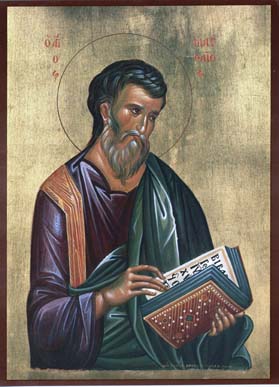Holy Apostle
Matthew
 St.
Matthew (meaning "gift of God") was identified as a tax
collector (Matthew 9:9; 10:3) and was of Jewish race. In the
other accounts of his meeting with Jesus (Mark 2:13, 14;
Luke 5:27-29), he is called Levi. This use of two different
names has led some scholars to argue for two different
persons, due to the absence of Levi from the apostolic
lists. Others, however, have argued that Matthew had a
double name, because the Jews frequently carried two names -
such as Simon/Peter and Saul/Paul. When he was called by
Jesus (Matthew 9:9), Matthew renounced the position of tax
collector and became His disciple. According to Christian
tradition, after Pentecost Matthew, filled with the Holy
Spirit, preached the gospel in many places, especially to
the Jews.
St.
Matthew (meaning "gift of God") was identified as a tax
collector (Matthew 9:9; 10:3) and was of Jewish race. In the
other accounts of his meeting with Jesus (Mark 2:13, 14;
Luke 5:27-29), he is called Levi. This use of two different
names has led some scholars to argue for two different
persons, due to the absence of Levi from the apostolic
lists. Others, however, have argued that Matthew had a
double name, because the Jews frequently carried two names -
such as Simon/Peter and Saul/Paul. When he was called by
Jesus (Matthew 9:9), Matthew renounced the position of tax
collector and became His disciple. According to Christian
tradition, after Pentecost Matthew, filled with the Holy
Spirit, preached the gospel in many places, especially to
the Jews.
The Gospel of Matthew, though it has come down to us in Greek, has a Jewish/Hebraic flavour, which is evident in its Aramaic expressions and forms, and its use of numerous quotations and arguments from the Old Testament. Furthermore, Matthew gives details of Jewish religious observations, and often uses Jewish style and techniques of argument. God's final judgement, pictured in apocalyptic images common in Jewish writings, is also emphasized. Papias, a second-century Christian author, preserves the tradition that Matthew wrote the sayings of Christ in Aramaic, the common language of the Jews at the time of Christ, and that others later freely translated this work into Greek.
Though the Gospel does not name Matthew as the author, all the early manuscripts attribute authorship to Matthew, one of the twelve disciples listed in the New Testament. His authorship is attested by the universal witness of the ancient Church.
Matthew's usual emblem as an evangelist is a man, because his genealogy emphasized the family ties of Christ. He is commemorated in the Orthodox Church on November 16.
Reference The Orthodox Study Bible
Copyright © 1993 by St. Athanasius Orthodox
Academy, Nelson ISBN 0-8407-8391-4